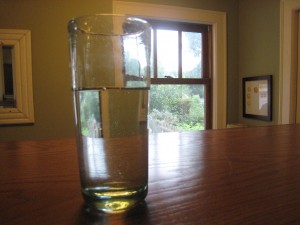Tag: clean’
Be Thankful for Clean Water
- by KitchenPantryScientist
This Thanksgiving, here is what I’m thankful for:
A nasty stomach virus burned through our house this week (I blame a communal bowl of popcorn.) Following the kids around, I cleaned up after them with disinfectant wipes and lots of soap and water. If I didn’t hear the comforting swoosh of the faucet following the sound of a flush, I’d yell “wash your hands!” When they emerged from the bathroom, I’d hand them a glass of water or bottle of sports drink to sip so they could replace the fluids they’d lost.
In Haiti, for most people there are no clean toilets and there is no clean water for hand washing. There often isn’t clean drinking water and ditches are filled with sewage. Over 1,000 people have already died in a recent cholera epidemic and countless more are infected. Cholera is a disease of people living with poor sanitation.
What can you do to help?
Click the link above to donate a day of clean water to someone in the third world. Here’s what P&G is doing now to help with the cholera epidemic in Haiti. You can click once a day!
According to the World Health Organization, waterborne diseases remain the leading cause of illness and death in the developing world. Every 20 seconds, a child in a developing country dies of a water-related illness. Bacterial diseases caused by E.coli and Vibrio Cholerea, parasites like Guinea Worm, viruses and protozoa are all carried by unclean water. Some of these potentially deadly organisms can be killed by boiling, but for many people in the world, firewood is scarce.
We don’t know how lucky we are. Be thankful for your clean drinking water, even if it tastes like chlorine. Be thankful for your toilet.
Happy Thanksgiving and don’t forget to wash your hands!
Many aid organizations and churches have programs to help people get access to clean water and proper sanitation, whether it’s by helping dig wells or sending bars of soap. WaterAid is a U.K.-based international non-profit organization that is helping bring not only clean water, but sanitation and hygiene programs to many villages desperate for clean water. The organization makes local women an integral part of the process. Proctor and Gamble, who is running the Clean Water Blogivation campaign, make a PUR powder which can be mixed with contaminated water to make it safe to drink. They have a Children’s Safe Drinking Water program and have been working with a number of organizations to distribute the PUR powder around the world to those who don’t have access to clean water.
There’s a fairly comprehensive list of water-born microbes on Wikipedia, and if you’d like to learn more, the World Health Organization and the Center for Disease Control are great resources.
What We Take for Granted
- by KitchenPantryScientist
The facts speak for themselves:
- Every 20 seconds, a child in a developing country dies of a water-related illness (World Health Organization)
- Waterborne diseases remain the leading cause of illness and death in the developing world. (World Health Organization)
- 46 percent of people on Earth do not have water piped to their homes (National Geographic)
- Women in developing countries walk an average of 3.7 miles to get water (National Geographic)
Shocking, isn’t it? It should at least give you pause as you fill up your child’s glass with clean tap water, or maybe even filtered tap water. Now, try to imaging walking 3.7 miles in the dark or the hot sun to bring home water that may or may not make your child sick, or even kill them. What choice would you have though? Water is life.
I recently signed up to participate in the Clean Water Blogivation campaign. If my blog receives the most votes, I could win an opportunity to be a change agent and join Dr. Greg Allgood on a clean water expedition to Africa and a $15,000 donation to my favorite charity tackling water issues. Much more importantly, each time someone votes for my blog post, P&G will donate a day’s worth of clean drinking water (2L) to a person in need in a developing country. Click on the “vote for this blogger” button above and clean drinking water for a day will be donated each time you vote! (You can vote once a day.)
The task of fetching water defines life for many people on this planet. National Geographic tells the story of an Ethiopian woman named Aylito who dropped out of school when she was eight to help her mother carry water from a dirty river. She spends eight hours a day walking to and from the river, up and down a mountain, three times to carry 50 pounds of water on her back. It is a life almost beyond imagining for most of us who live in developed countries. However, one can imagine that people who work so hard to get so little water have very little water to spare for sanitation, like hand-washing, or washing clothes. According to National Geographic, proper hand washing alone can reduce diarrheal disease by 45%. Many people cannot afford soap though.
What diseases are carried by dirty water? You name it: bacterial diseases like E.coli and Vibrio Cholerea, parasites like Guinea Worm, viruses and protozoa. Some of these pathogens can be killed by boiling, but for many, firewood is scarce. Sometimes, it’s too much water from flooding that causes drinking water to be unsafe. (The floods in Pakistan are causing problems right now.)
There’s a fairly comprehensive list of water-born microbes on Wikipedia, and if you’d like to learn more, the World Health Organization and the Center for Disease Control are great resources.
The obvious question is, “what can I do to help?” Many aid organizations and churches have programs to help people get access to clean water and proper sanitation, whether it’s by helping dig wells or sending bars of soap. WaterAid is a U.K.-based international non-profit organization that is helping bring not only clean water, but sanitation and hygiene programs to many villages desperate for clean water. The organization makes local women an integral part of the process. Proctor and Gamble, who is running the Clean Water Blogivation campaign, make a PUR powder which can be mixed with contaminated water to make it safe to drink. They have a Children’s Safe Drinking Water program and have been working with a number of organizations to distribute the PUR powder around the world to those who don’t have access to clean water.

